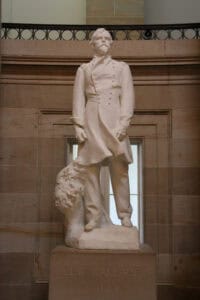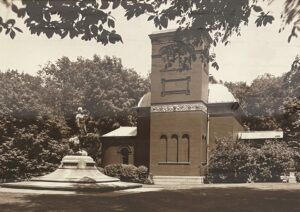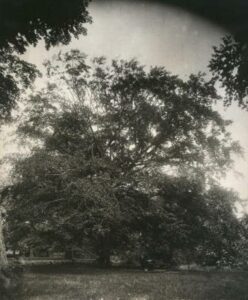On the grounds of the General Lew Wallace Study & Museum there is a large bronze statue of Lew Wallace in his Civil War attire. Lew was selected to be the second of two Hoosiers recognized with statues in Statuary Hall in the U.S. Capitol and a committee was formed to move the project forward. Lew’s son, Henry, was a member of the committee and in 1909 he travelled to Paris to inspect the life-size white, marble statue being created by the sculptor Andrew O’Connor. Henry was so impressed with the marble statue that he requested a bronze replica.
To make the bronze replica, a plaster mold was taken of the original marble statue prior to its shipment and installation in Washington, D.C. From this plaster mold a wax figure was made and sent to the Hebrard Art Bronze Foundry on the banks of the Seine River in Paris. At that point, the plaster mold was destroyed. The art foundry and gallery was owned by Adrien Hebrard and it was one of the most famous foundries in France. It is still well known for its castings of statues by Rembrandt Bugatti, Degas, and Rodin among others. The foundry continued in business until orders for art castings significantly declined during the worldwide 1930s Depression and it closed in 1937.

In 1910, just after the wax figure of Wallace was delivered to the foundry, the weather changed and without warning it was flooded by the Seine River and the statue was threatened. Due to the high regard in which the French government held Lew Wallace, the French Minister of Fine Arts, M. Dujardin-Beaumetz, stepped in and ordered that the statue be saved by workmen of the state. Saving the statue was delayed for a short time because the wax was so fresh it was too soft to be handled and a method to move the statue had to be devised. When workmen could finally rescue the figure of Wallace, the crew had to work in water up to their waists. To safeguard the wax figure, the Minister of Fine Arts ordered that it be moved to the Garde-Meuble de la Couronne a government museum and storehouse for historic furniture and art objects belonging to France.
After the flood waters receded and the foundry was back in operation, the figure was returned and prepared for casting. Had the casting not been flawless, the bronze statue could not have been made as the plaster mold was broken during the removal process and the marble statue already shipped to the United States.
The original white marble statue was delayed in its completion in Paris and then got lost in transit across the Atlantic Ocean, arriving later than expected in New York before shipment to Washington, D.C. In a strange twist of fate, the bronze casting ordered by Henry was also lost during shipment across the ocean. There was a long delay in locating it, and the installation planned for the summer of 1910 was delayed until October.
Henry Wallace took great pride in this bronze replica of his father. Not only was he responsible for authorizing the replica; he selected the site of the historic Ben-Hur Beech tree for the final installation on the grounds. He commissioned Sidney Speed of Crawfordsville to design and install the limestone base. After more than 100 years, it stands as a lasting tribute of the affection and high regard that the son, Henry, held for his father, Lew. It has also served as a highlight for guests visiting the museum and as a centerpiece of the property for generations of neighborhood children who walked the Wallace wall and have played on the museum grounds.
